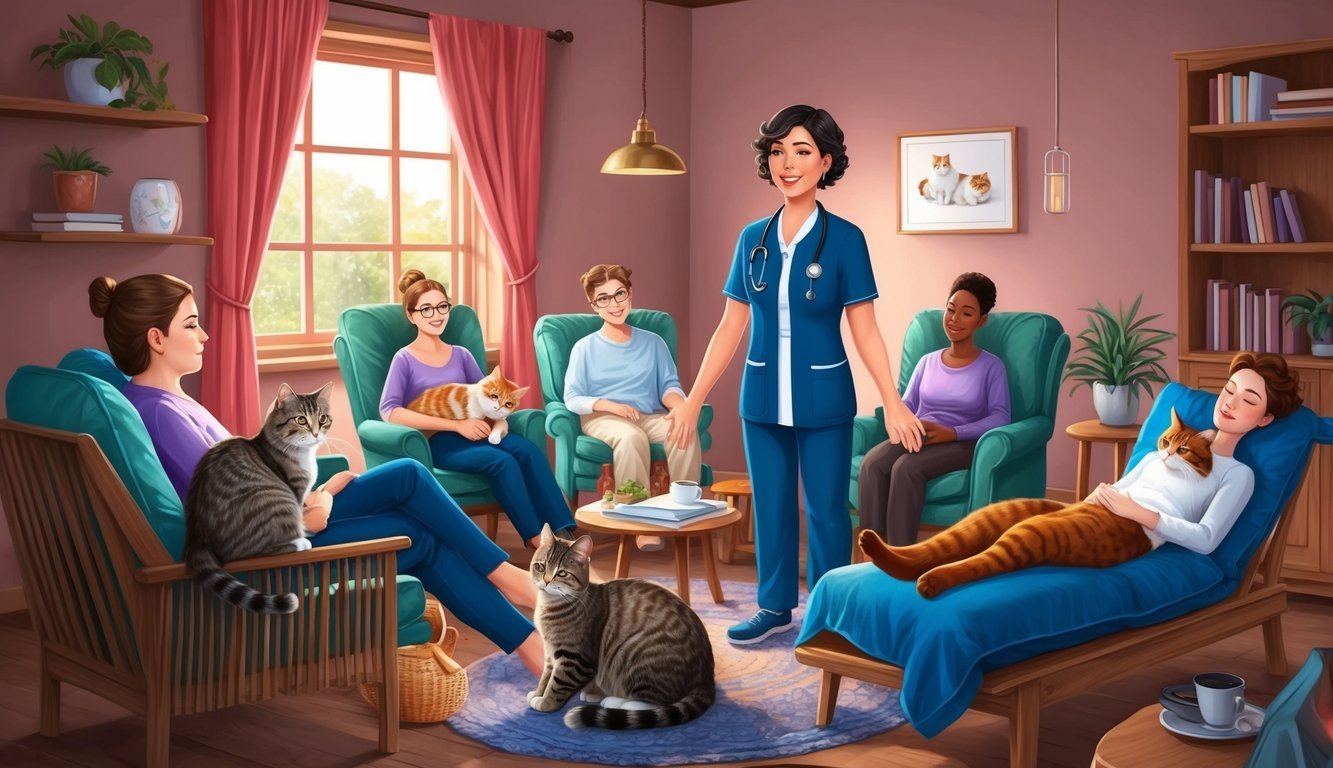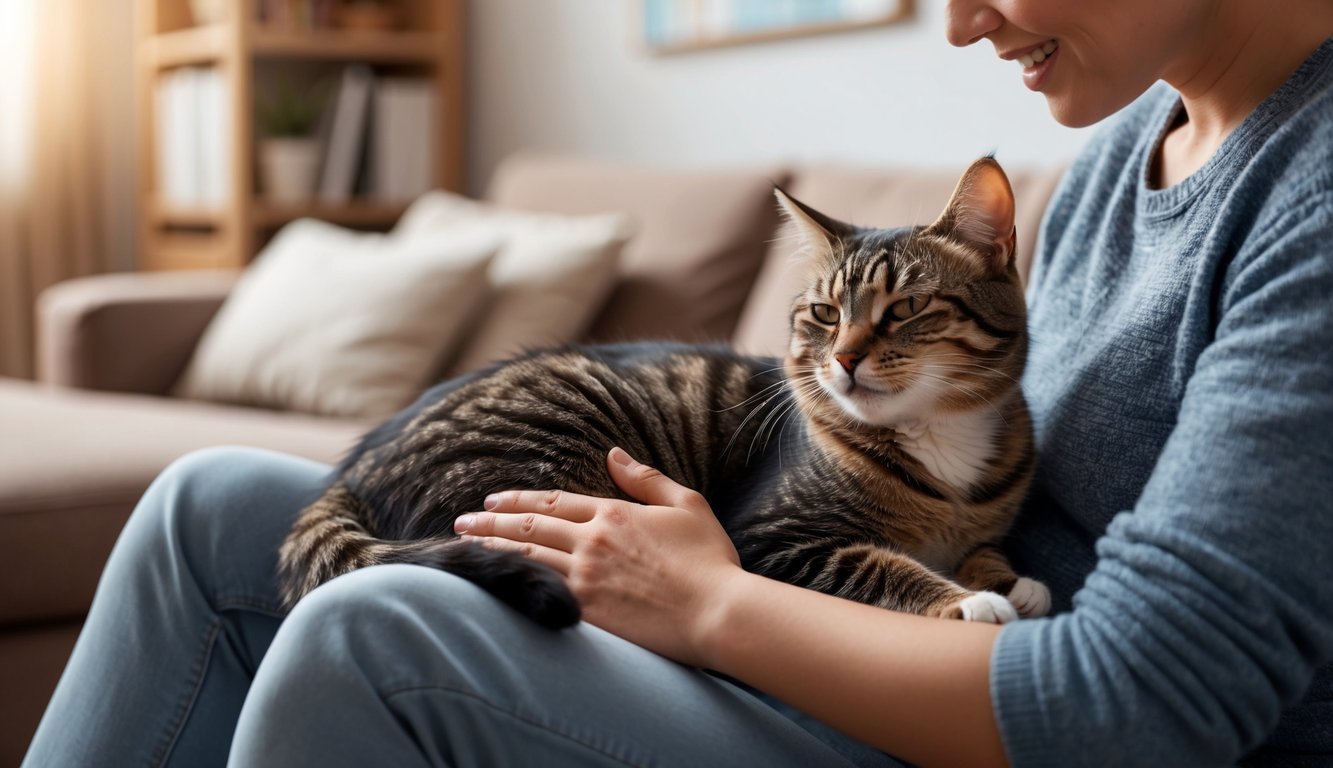Cats have long been cherished companions, but you might not realize their profound role in your healing journey.
Feline therapy showcases how these gentle creatures provide emotional support and promote healing, making a notable difference in people’s lives.
From comforting purrs to their playful antics, cats can help alleviate stress and anxiety, enhancing your overall well-being.

If you’ve ever felt calm wash over you while petting a cat, you’re not alone.
Many studies reveal that spending time with cats can lower blood pressure and even trigger the release of feel-good hormones like oxytocin.
Whether you’re dealing with physical illness or emotional struggles, having a cat by your side could be a key component in your recovery.
With their unique ability to connect, cats can create a calm therapeutic environment.
You may find that simply being in the presence of a cat allows you to open up and heal in ways you never thought possible.
It’s not just about companionship; it’s about the powerful bond that fosters resilience and comfort during challenging times.
The Role of Cats in Therapy
Cats serve a unique and beneficial role in the therapy landscape, often providing a calming presence that supports mental well-being.
Their ability to connect with humans goes beyond mere companionship, making them valuable assets in various therapeutic settings.
Understanding Feline Therapy
When you think of therapy animals, you might picture dogs, but therapy cats are equally impactful.
These specially trained felines visit hospitals, schools, and nursing homes to offer comfort.
Their gentle demeanor can help ease feelings of anxiety and depression.
Cats provide a soft touch and engage in soothing purring, which can lower stress levels.
You may find that just petting a cat can elevate your mood, making them ideal for animal-assisted therapy programs.
Cats vs. Other Therapy Animals
Cats and dogs both serve as therapy animals, but they bring different qualities to the table.
Dogs are often more energetic and may require more interaction, while cats typically offer calm, quiet companionship.
A therapy cat’s presence can be particularly beneficial in settings where patients require a serene atmosphere, like hospitals or long-term care facilities.
They help create a comforting environment without overwhelming individuals, showcasing their unique role in therapy.
The Science of Purring
Purring isn’t just a soothing sound; it has real physiological benefits.
Research suggests that the vibrations from a cat’s purr fall within the 25-150 Hz range, which is known to promote healing.
When purring occurs, it can lower your heart rate and blood pressure, contributing to a feeling of calm.
This natural mechanism can aid in reducing anxiety and enhancing feelings of safety and comfort, making cats effective companions in therapeutic settings.
Incorporating therapy cats into treatment plans offers a holistic approach to mental health, allowing you to experience the calming effects that only these remarkable animals can provide.
Benefits of Therapy Cats
Therapy cats offer a range of benefits that enhance emotional well-being, support mental health treatment, and improve physical health.
Their presence can be soothing, promoting a sense of comfort and security for individuals in need.
Emotional and Psychological Advantages
Having a therapy cat around can significantly uplift your mood.
Their gentle purring and playful nature can trigger the release of oxytocin, a hormone linked to feelings of love and bonding.
This can lead to a decrease in anxiety and depression, making daily challenges feel more manageable.
The psychological benefits of interacting with your therapy cat include reduced stress levels.
Spending time with these animals can reduce your heart rate, contributing to a calming effect.
Seeing their affectionate behavior can provide reassurance and comfort during tough times.
Physical Health Improvements
The soothing companionship of therapy cats extends beyond emotional support; it can also positively impact your physical health.
Studies have shown that just being around cats can lower blood pressure, which is crucial for maintaining good cardiovascular health.
Their presence can also alleviate stress-related symptoms, resulting in improved heart rates.
As you pet a therapy cat, you may find your body producing endorphins, which further enhances your sense of well-being.
This physical reaction supports a healthier lifestyle, promoting relaxation and recovery.
Support in Mental Health Treatment
Therapy cats play a vital role in mental health treatment plans.
They can facilitate communication during therapy sessions, especially for those who may struggle to open up.
The comfort pets provide can create an inviting atmosphere that encourages sharing.
Their consistent presence can also reinforce therapeutic routines.
Regular interaction with a therapy cat can become an integral part of self-care practices, helping you to better manage psychological challenges.
This type of support can effectively complement traditional treatment, providing a holistic approach to mental wellness.
Therapeutic Interactions with Cats
Interactions with therapy cats can create profound emotional connections, enhancing the human-animal bond.
These experiences are often uplifting and can be tailored to individual needs, making them beneficial in various clinical settings.
Bonding with Therapy Cats
Building a bond with a therapy cat can be an enriching experience.
As you spend time with these animals, you’ll notice how their gentle demeanor fosters trust and companionship.
This connection can ease feelings of loneliness and anxiety, allowing you to open up emotionally.
Cats are naturally intuitive and can sense your mood.
When they approach you or purr while you’re feeling down, it can create a sense of comfort.
The act of petting a cat releases oxytocin, often referred to as the “bonding hormone,” which further strengthens this interaction.
Activities and Exercises
Incorporating activities with therapy cats can promote movement and engagement.
Simple activities like playing with toys or guiding them through an obstacle course can provide physical benefits while boosting your mood.
These exercises can also stimulate cognitive functions, helping improve attention and focus.
Engaging with a cat during these activities may encourage conversations and social interactions, particularly in group settings like nursing homes.
Watching a cat chase a string can even bring laughter, which is an important emotional outlet.
Cats in Clinical Settings
Therapy cats are increasingly present in clinical environments such as hospitals and nursing homes.
Their calming presence can significantly enhance the atmosphere, providing comfort to patients undergoing treatment.
In these settings, therapy cats often participate in guided sessions where patients can interact with them to relieve stress or anxiety.
The simple act of cuddling a cat can lead to lower blood pressure and increased relaxation.
This unique approach integrates emotional support with physical healing, making therapy cats a valuable asset in healthcare.
Cat Therapy in Practice
Cat therapy is an engaging and effective way to promote healing and well-being.
This practice combines the unique qualities of cats with mindful approaches tailored to your needs, creating a comforting environment that encourages connection and emotional support.
The Process of Cat Therapy
In a typical cat therapy session, the environment is designed to be calm and welcoming.
You might find yourself in a cozy room filled with soft lighting and comfortable seating.
The therapy cat interacts with you in a gentle manner, often encouraging physical touch through petting or cuddling.
The focus is on building a connection, helping you feel at ease.
Sessions often last between 30 minutes to an hour, allowing ample time for interaction.
You’ll notice that the cat’s purring and affectionate behaviors can create a soothing atmosphere, helping to alleviate stress and anxiety.
This process is beneficial for various demographics, including children and adults facing challenges like autism, PTSD, or depression.
Studies have shown that the presence of a therapy cat can significantly enhance communication skills and emotional resilience.
Training Therapy Cats
Training for therapy cats is comprehensive and tailored to their innate behaviors.
These cats undergo specific socialization processes to ensure they are comfortable in various environments.
This involves exposing them gradually to new experiences, people, and sounds to build their confidence.
Therapy cats also learn to respond positively to interactions.
This includes being calm in high-stress situations and showing affection when needed.
Organizations such as Pet Partners are instrumental in establishing guidelines for training, emphasizing the importance of a gentle temperament and adaptability.
Not every cat is suited for therapy work.
Those selected are typically evaluated for their personality traits, ensuring they possess a natural inclination to connect with people in therapeutic settings.
Where to Find Therapy Cats
You can discover therapy cats in several places, including hospitals, schools, and community centers.
Many animal therapy programs partner with local organizations to facilitate these connections.
Pet Partners is a prominent organization that offers resources for finding registered therapy animals in your area.
Their website allows you to search for therapy cats, providing information on accessible programs and events.
Additionally, local shelters often have connections with therapy cat programs, promoting the adoption of suitable cats.
If you’re interested in therapy sessions, consider contacting these organizations to explore opportunities that would suit your needs.
Psychosocial Aspects of Feline Companionship
Feline companionship offers unique psychosocial benefits that can enhance social skills and help combat feelings of loneliness.
These aspects of having a cat are crucial for emotional well-being and building connections.
Enhancing Social Skills and Connection
Having a cat around can boost your social skills in surprising ways.
When you share your life with a feline friend, you often find yourself engaging in conversations about them.
You might meet fellow cat lovers at the vet or in local pet stores.
This interaction can lead to new friendships based on shared interests.
Cats create a common ground for discussions, fostering connections that might not have happened otherwise.
Their playful nature also encourages bonding activities, such as playing with toys, which can break the ice with others.
Coping with Loneliness and Despair
Loneliness can weigh heavily, but having a cat provides a comforting presence.
Their non-judgmental nature means they accept you just as you are.
This unconditional support helps reduce feelings of isolation.
When you’re feeling down, a cat’s gentle purring can be incredibly soothing.
Their companionship serves as a reminder that you are not alone.
A simple cuddle session or watching them play can lift your spirits and offer moments of joy, breaking the cycle of despair.
In moments of stress, focusing on your cat’s behavior can also be a great distraction.
Their antics can bring laughter and a renewed sense of purpose to your day.
Cats as Agents of Comfort and Joy

Cats offer unique emotional support that can significantly enhance your well-being.
Their presence can bring immense joy and a deep sense of comfort, making tough times a little easier to bear.
Stress Reduction and Relaxation
Imagine coming home after a long day, feeling the weight of the world on your shoulders.
When you see your cat, that stress can begin to melt away.
The gentle sound of a cat’s purr has a scientifically proven calming effect.
Research suggests that this soothing vibration can lower your heart rate and reduce anxiety.
Spending time petting or playing with your cat can also act as a form of mindfulness.
You find yourself focusing on their soft fur, their playful antics, and for a moment, the outside world fades away.
Creating a cozy environment filled with your feline friend’s company promotes relaxation, making it easier to unwind.
Unconditional Love and Support
Cats have an innate ability to provide comfort through their unconditional love.
Whether you are celebrating a small victory or navigating a challenging moment, your cat is there, offering companionship without judgment.
This emotional connection can be particularly beneficial during stressful periods.
When you feel down, your cat might curl up next to you, providing warmth and solace.
Their presence reassures you that you’re not alone.
This simple bond can lead to increased feelings of happiness and contentment, enhancing your overall quality of life.
Embracing this love can be a powerful tool for mental wellness.
Addressing Psychological Disorders with Cat Therapy

Cat therapy offers several key approaches to help individuals cope with psychological disorders, particularly anxiety and depression.
By fostering connection and comfort, these furry companions can play a significant role in emotional healing.
Alleviating Symptoms of Anxiety and Depression
Engaging with cats can lighten the weight of anxiety and depression.
The simple act of petting a cat can release oxytocin, a hormone that promotes bonding and reduces stress.
This physical interaction fosters a sense of calm, helping to alleviate feelings of panic and sadness.
Moreover, spending time with a cat encourages you to focus on the present moment.
This mindfulness practice can help distract from racing thoughts and negative emotions.
Those who experience anxiety disorders often find that the soft purrs and gentle nudges from a cat offer comfort and a sense of security.
In many therapeutic settings, cats are integrated into treatment plans to enhance emotional support.
The presence of a therapy cat can create an environment that promotes psychological well-being, leading to improvements in mood and a sense of connection.
Therapeutic Benefits for PTSD and Anxiety Disorders
For individuals coping with PTSD, the soothing presence of a cat can be particularly beneficial.
Cats are attuned to human emotions and can often sense when you are experiencing distress.
Their low-key demeanor may help ground you during moments of panic or anxiety.
Studies indicate that interaction with therapy cats can significantly reduce symptoms of PTSD and anxiety disorders.
The rhythmic sound of a cat’s purr is thought to have a calming effect on the nervous system, promoting relaxation.
Additionally, the routine of caring for a cat can provide structure and purpose, which is often vital for those managing trauma-related symptoms.
It encourages responsibility and can foster a stronger connection to the world around you.
Through these interactions, many clients report a decrease in anxiety levels and an increase in overall emotional stability.
The Future of Feline-Assisted Healing

Feline-assisted healing is gaining momentum, with promising research and practical applications showing how cats can significantly benefit mental and physical health.
You’ll find exciting developments in this field that could transform therapeutic practices in the years to come.
Research and Developments
Research into feline-assisted therapy is expanding rapidly.
Studies are focusing on how interactions with cats can reduce anxiety, stress, and depression among various populations.
Recent projects have shown that cat comfort can improve conditions for individuals in hospitals and care facilities.
These studies leverage the soothing presence of cats to promote emotional well-being.
As researchers gather data, they’re uncovering more about the specific benefits cats provide.
For instance, a partnership involving Cat Person is investigating the unique bond between cats and humans.
This research aims to quantify therapeutic benefits more accurately, enhancing the understanding of cats’ roles in therapy.
With more comprehensive studies, institutions may be more inclined to integrate therapy cats into treatment plans.
Expanding the Use of Therapy Cats
Therapy cats are gradually becoming integral to emotional and physical health initiatives.
You may find these animals in various settings, from hospitals to schools and rehabilitation centers.
The unique qualities of cats—such as their calming purrs and gentle demeanor—make them ideal for assisting people dealing with stress or trauma.
Programs are underway to train more cats for therapeutic purposes, making this option more accessible.
Moreover, awareness is increasing about the benefits therapy cats can provide for individuals with specific needs, including veterans and children with autism.
This growing focus highlights the potential for cats to aid in social development and emotional recovery.

